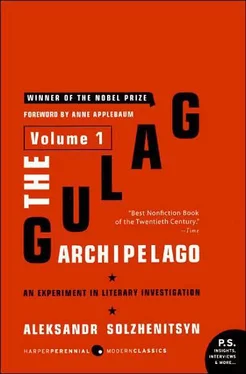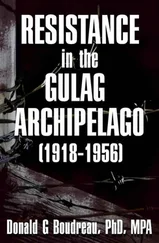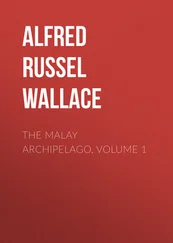18. The fact that their efforts in defending it were very feeble, that they were beset by hesitations, and that they renounced it right away is another matter. For all that, their guilt was no less.
19. And it had indeed been a failure, although this did not become clear immediately.
20. In the same way, all the local Russian governments, and those in outlying areas, were illegal—those in Archangel, Samara, Ufa or Omsk, the Ukraine, the Don, the Kuban, the Urals or Transcaucasia—inasmuch as they all declared themselves to be governments after the Council of People’s Commissars had declared itself to be the government.
21. The title of “prosecutor” had by now been restored to him.
22. Krylenko, op. cit., p. 183.
23. And what hadn’t those chatterboxes said in the course of a lifetime?
24. Krylenko, op. cit., p. 236. (What lingo!)
26. Krylenko, op. cit., p. 251.
27. Ibid., p. 253.
30. Ibid., p. 185.
32. Ibid.
33. Ibid., p. 325.
35. Ibid., p. 238. 38. Ibid., p. 319.
36. Ibid., p. 322. 39. Ibid., p. 407.
41. Many hypotheses were advanced about his return. Only a little while ago, a certain Ardamatsky, a person obviously connected with the archives and personnel of the Committee for State Security, published a story which, despite being adorned with pretentiously inflated literary gewgaws, is evidently close to the truth. (The magazine Neva, No. 11, 1967.) Having induced certain of Savinkov’s agents to betray him and having deceived others, the GPU used them to set a foolproof trap, convincing Savinkov that inside Russia a large underground organization was languishing for lack of a worthy leader! It would have been impossible to devise a more effective trap! And it would have been impossible for Savinkov, after such a confused and sensational life, merely to spin it out quietly to the end in Nice. He couldn’t bear not trying to pull off one more feat and not returning to Russia and his death.
42. And we, silly prisoners of a later Lubyanka, confidently parroted to one another that the steel nets hanging in the Lubyanka stairwells had been installed after Savinkov had committed suicide there. Thus do we succumb to fancy legends to the extent of forgetting that the experience of jailers is, after all, international in character. Such nets existed in American prisons as long ago as the beginning of the century—and how could Soviet technology have been allowed to lag behind?
In 1937, when he was dying in a camp in the Kolyma, the former Chekist Artur Pryubel told one of his fellow prisoners that he had been one of the four who threw Savinkov from a fifth-floor window into the Lubyanka court-yard! (And there is no conflict between that statement and Ardamatsky’s recent account: There was a low sill; it was more like a door to the balcony than a window—they had picked the right room! Only, according to Ardamatsky, the guards were careless; according to Pryubel, they rushed him all together.)
Thus the second riddle, the unusually lenient sentence, was unraveled by the crude third “riddle.”
The story ascribed to Pryubel could not be checked, but I had heard it, and in 1967 I told it to M. P. Yakubovich. He, with his still youthful enthusiasm and shining eyes, exclaimed: “I believe it. Things fit! And I didn’t believe Blyumkin; I thought he was just bragging.” What he had learned was this: At the end of the twenties, Blyumkin had told Yakubovich, after swearing him to secrecy, that he was the one who had written Savinkov’s so-called suicide note, on orders from the GPU. Apparently Blyumkin was allowed to see Savinkov in his cell constantly while he was in prison. He kept him amused in the evenings. (Did Savinkov sense that death was creeping up on him… sly, friendly death, which gives you no chance to guess the form your end will take?) And this had helped Blyumkin acquire Savinkov’s manner of speech and thought, had enabled him to enter into the framework of his last ideas.
And they ask: Why throw him out the window? Wouldn’t it have been easier simply to poison him? Perhaps they showed someone the remains or thought they might need to.
And where, if not here, is the right place to report the fate of Blyumkin, who for all his Chekist omnipotence was fearlessly brought up short by Mandelstam. Ehrenburg began to tell Blyumkin’s story, and suddenly became ashamed and dropped the subject. And there is a story to tell, too. After the 1918 rout of the Left SR’s, Blyumkin, the assassin of the German Ambassador Mirbach, not only went unpunished, was not only spared the fate of all the other Left SR’s, but was protected by Dzerzhinsky, just as Dzerzhinsky had wanted to protect Kosyrev. Superficially he converted to Bolshevism, and was kept on, one gathers, for particularly important assassinations. At one point, close to the thirties, he was secretly sent to Paris to kill Bazhenov, a member of the staff of Stalin’s secretariat who had defected, and one night he succeeded in throwing him off a train. However, his gambler’s blood, or perhaps his admiration of Trotsky, led Blyumkin to the Princes’ Islands in Turkey, where Trotsky was living. He asked Trotsky whether there were any assignments he could carry out for him in the Soviet Union, and Trotsky gave him a package for Radek. Blyumkin delivered it, and his visit to Trotsky would have remained a secret had not the brilliant Radek already been a stool pigeon. Radek brought down Blyumkin, who was thereupon devoured by the maw of the monster his own hands had suckled with its first bloody milk.
1. Lenin, fifth edition, Vol. 54, pp. 265-266.
2. Krylenko, Za Pyat Let, p. 437.
3. And the members of the tribunal were the old revolutionaries Vasilyev-Yuzhin and Antonov-Saratovsky. The very simple folk sound of their family names inclines one to a favorable reaction. They are easy to remember. And when suddenly, in 1962, obituaries of certain victims of repression appeared in Izvestiya, whose signature was at the bottom? That of the long-lived Antonov-Saratovsky!
5. Izvestiya , May 24, 1929.
6. And it is quite possible that this failure of his was held against him by the Leader and led to the symbolic destruction of the prosecutor—on the very same guillotine as his victims.
7. Protsess Prompartii (The Trial of the Promparty), Moscow, Sovetskoye Zakonodatelstvo (Soviet Legislation Publishing House), 1931.
11. ibid., p. 365.
12. Ibid., p. 204.
14. Ibid., p. 204.
15. Ibid., p. 425.
17. Who drew that arrow for Krylenko on a cigarette pack—was it not drawn by the same hand that thought up our entire defense strategy in 1941?
23. Ibid., p. 452.
25. Ivanov-Razumnik, Tyurmy i Ssylki (Prisons and Exiles), New York, Chekhov Publishing House, 1953.
Читать дальше












